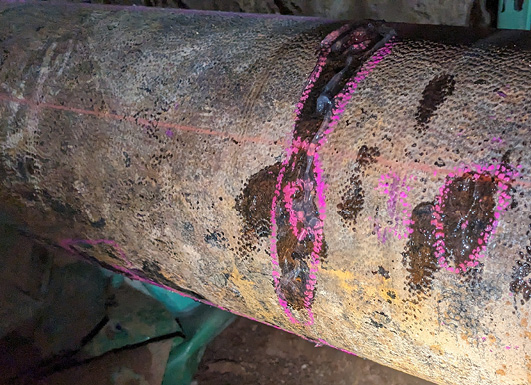
The Butterfly Valve Mystery
CPM’s recent project with a water utility client captured amazing footage providing a simple explanation for the (considered) inconsistent data captured through the client’s modeling software.
CPM was contracted to perform a condition assessment inspection along two sections of 8-inch ductile iron pipe (DIP) waste activated sludge lines located in Arizona. CPM utilized an Electromagnetic Bracelet Probe™ (BP) and an Ultrasonic Thickness (UT) gauge to collect pipe wall thickness data at the exposed segments of pipe.
Metallic wastewater pipelines such as DIP experience corrosion and pipe wall loss due to exposure to hydrogen sulfide and other caustic gases common in wastewater pipes. Generally, this deterioration is focused along the top portion of the pipeline though corrosion can be found across the entire diameter.
CPM was made aware that previous inspetion efforts had been performed along the pipeline segments including closed circuit television (CCTV) video recording and analysis. The locations where the BP scans and UT readings were performed were chosen due to their proximity to air release valves (ARVs). ARVs are typically placed at high points where gas accumulates, and as noted, the gases associated with wastewater pipelines can severely expedite corrosion. Therefore, the inspection locations were estimated to have greater than average levels of corrosion and pipe wall loss.
The pipeline was excavated and exposed at each location, providing the necessary space to perform the BP scans properly. While both sections were buried beneath pavement, location one was located at the dead-end of a low-traffic roadway while location two required traffic control as it was near a busy intersection. Both inspections were completed at night in order to minimize safety risks.
An external inspection on two exposed segments of DIP was performed. The goal of the inspection was to obtain thickness measurements of the pipe wall to understand their current condition and compare the data to the original design and manufacturing data (as availability of this information allowed). The equipment used to perform these tasks included:
BP scanning to determine areas of interest along two sections of an 8-inch sludge pipeline was performed Each location included 3- to 4-feet of exposed pipe and three scans were performed covering the entire circumference. An ultrasonic thickness gauge was used to produce precise wall thickness measurements concerning areas. Each of the tools used was calibrated prior to mobilization and once again on-site, providing full confidence in the data collected.
The condition assessent inspection effort determined that each pipeline exhibited areas of wall loss of varying degree and area. In some cases, the wall loss approached and exceeded 50% across several inches to over one foot of pipe. The inspection locations were near high spots on the line, suggesting that hydrogen sulfide gas accumulation is the primary driver of wall loss. Based on the experience of CPM technicians and engineers, this level of degradation is common for metallic wastewater pipelines of this age.
While the inspection areas were small relative to the entire span of the sludge pipeline, this inspection served as a preliminary look into the system’s current condition. Based on the results gained, it was recommended that additional inspection(s) be performed with greater coverage, such as those produced with in-line inspection technologies.





CPM’s recent project with a water utility client captured amazing footage providing a simple explanation for the (considered) inconsistent data captured through the client’s modeling software.

CPM was contracted to perform a phased pipe condition inspection utilizing INGU Pipers® free floating pre-screening inspection tools, Electromagnetic Bracelet Probe™ (BP) scanning, and ultrasonic thickness (UT) measurements on two wastewater force main pipelines.

Protecting human divers one Deep Trekker PIVOT inspection at a time. How a subaqueous swimming CCTV inspection solved the unknown in a 48-inch, potable water, intake pipeline 600-feet below.

An Arizona suburb pursues a long-term program to identify and locate leaks across its potable water pipeline system.

How one North Texas city is using new technology to protect its constituents from unforeseen water outages and loss.

Blazing the trail of large diameter pressure pipe rehabilitation in the U.S.